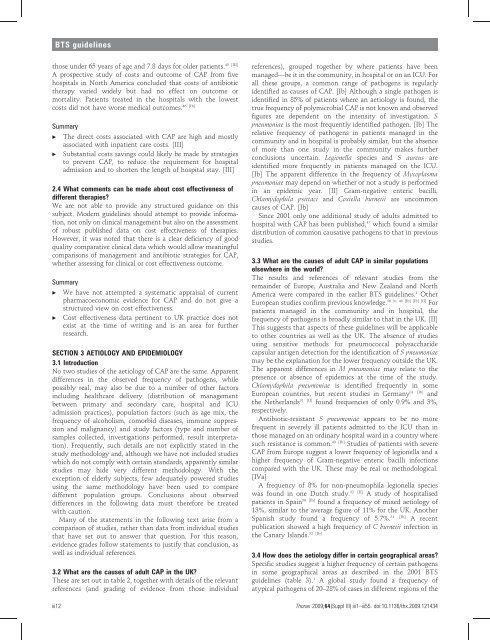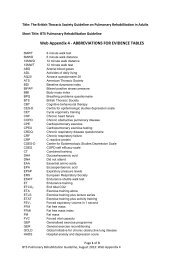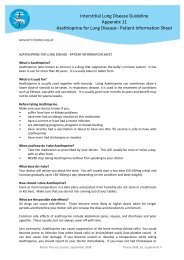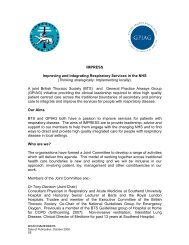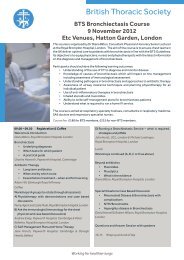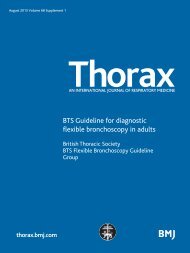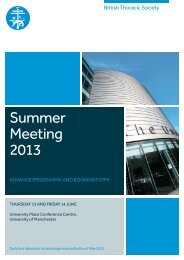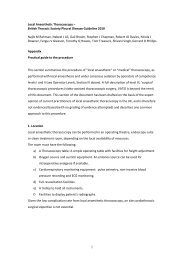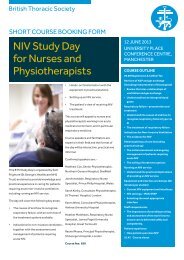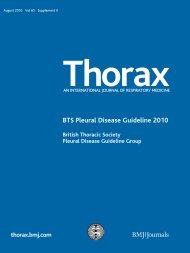Guidelines for the management of community ... - Brit Thoracic
Guidelines for the management of community ... - Brit Thoracic
Guidelines for the management of community ... - Brit Thoracic
Create successful ePaper yourself
Turn your PDF publications into a flip-book with our unique Google optimized e-Paper software.
BTS guidelines<br />
45 [III]<br />
those under 65 years <strong>of</strong> age and 7.8 days <strong>for</strong> older patients.<br />
A prospective study <strong>of</strong> costs and outcome <strong>of</strong> CAP from five<br />
hospitals in North America concluded that costs <strong>of</strong> antibiotic<br />
<strong>the</strong>rapy varied widely but had no effect on outcome or<br />
mortality. Patients treated in <strong>the</strong> hospitals with <strong>the</strong> lowest<br />
46 [Ib]<br />
costs did not have worse medical outcomes.<br />
Summary<br />
c The direct costs associated with CAP are high and mostly<br />
associated with inpatient care costs. [III]<br />
c Substantial costs savings could likely be made by strategies<br />
to prevent CAP, to reduce <strong>the</strong> requirement <strong>for</strong> hospital<br />
admission and to shorten <strong>the</strong> length <strong>of</strong> hospital stay. [III]<br />
2.4 What comments can be made about cost effectiveness <strong>of</strong><br />
different <strong>the</strong>rapies?<br />
We are not able to provide any structured guidance on this<br />
subject. Modern guidelines should attempt to provide in<strong>for</strong>mation,<br />
not only on clinical <strong>management</strong> but also on <strong>the</strong> assessment<br />
<strong>of</strong> robust published data on cost effectiveness <strong>of</strong> <strong>the</strong>rapies.<br />
However, it was noted that <strong>the</strong>re is a clear deficiency <strong>of</strong> good<br />
quality comparative clinical data which would allow meaningful<br />
comparisons <strong>of</strong> <strong>management</strong> and antibiotic strategies <strong>for</strong> CAP,<br />
whe<strong>the</strong>r assessing <strong>for</strong> clinical or cost effectiveness outcome.<br />
Summary<br />
c We have not attempted a systematic appraisal <strong>of</strong> current<br />
pharmacoeconomic evidence <strong>for</strong> CAP and do not give a<br />
structured view on cost effectiveness.<br />
c Cost effectiveness data pertinent to UK practice does not<br />
exist at <strong>the</strong> time <strong>of</strong> writing and is an area <strong>for</strong> fur<strong>the</strong>r<br />
research.<br />
SECTION 3 AETIOLOGY AND EPIDEMIOLOGY<br />
3.1 Introduction<br />
No two studies <strong>of</strong> <strong>the</strong> aetiology <strong>of</strong> CAP are <strong>the</strong> same. Apparent<br />
differences in <strong>the</strong> observed frequency <strong>of</strong> pathogens, while<br />
possibly real, may also be due to a number <strong>of</strong> o<strong>the</strong>r factors<br />
including healthcare delivery (distribution <strong>of</strong> <strong>management</strong><br />
between primary and secondary care, hospital and ICU<br />
admission practices), population factors (such as age mix, <strong>the</strong><br />
frequency <strong>of</strong> alcoholism, comorbid diseases, immune suppression<br />
and malignancy) and study factors (type and number <strong>of</strong><br />
samples collected, investigations per<strong>for</strong>med, result interpretation).<br />
Frequently, such details are not explicitly stated in <strong>the</strong><br />
study methodology and, although we have not included studies<br />
which do not comply with certain standards, apparently similar<br />
studies may hide very different methodology. With <strong>the</strong><br />
exception <strong>of</strong> elderly subjects, few adequately powered studies<br />
using <strong>the</strong> same methodology have been used to compare<br />
different population groups. Conclusions about observed<br />
differences in <strong>the</strong> following data must <strong>the</strong>re<strong>for</strong>e be treated<br />
with caution.<br />
Many <strong>of</strong> <strong>the</strong> statements in <strong>the</strong> following text arise from a<br />
comparison <strong>of</strong> studies, ra<strong>the</strong>r than data from individual studies<br />
that have set out to answer that question. For this reason,<br />
evidence grades follow statements to justify that conclusion, as<br />
well as individual references.<br />
3.2 What are <strong>the</strong> causes <strong>of</strong> adult CAP in <strong>the</strong> UK?<br />
These are set out in table 2, toge<strong>the</strong>r with details <strong>of</strong> <strong>the</strong> relevant<br />
references (and grading <strong>of</strong> evidence from those individual<br />
iii12<br />
references), grouped toge<strong>the</strong>r by where patients have been<br />
managed—be it in <strong>the</strong> <strong>community</strong>, in hospital or on an ICU. For<br />
all <strong>the</strong>se groups, a common range <strong>of</strong> pathogens is regularly<br />
identified as causes <strong>of</strong> CAP. [Ib] Although a single pathogen is<br />
identified in 85% <strong>of</strong> patients where an aetiology is found, <strong>the</strong><br />
true frequency <strong>of</strong> polymicrobial CAP is not known and observed<br />
figures are dependent on <strong>the</strong> intensity <strong>of</strong> investigation. S<br />
pneumoniae is <strong>the</strong> most frequently identified pathogen. [Ib] The<br />
relative frequency <strong>of</strong> pathogens in patients managed in <strong>the</strong><br />
<strong>community</strong> and in hospital is probably similar, but <strong>the</strong> absence<br />
<strong>of</strong> more than one study in <strong>the</strong> <strong>community</strong> makes fur<strong>the</strong>r<br />
conclusions uncertain. Legionella species and S aureus are<br />
identified more frequently in patients managed on <strong>the</strong> ICU.<br />
[Ib] The apparent difference in <strong>the</strong> frequency <strong>of</strong> Mycoplasma<br />
pneumoniae may depend on whe<strong>the</strong>r or not a study is per<strong>for</strong>med<br />
in an epidemic year. [II] Gram-negative enteric bacilli,<br />
Chlamydophila psittaci and Coxiella burnetii are uncommon<br />
causes <strong>of</strong> CAP. [Ib]<br />
Since 2001 only one additional study <strong>of</strong> adults admitted to<br />
hospital with CAP has been published, 47 which found a similar<br />
distribution <strong>of</strong> common causative pathogens to that in previous<br />
studies.<br />
3.3 What are <strong>the</strong> causes <strong>of</strong> adult CAP in similar populations<br />
elsewhere in <strong>the</strong> world?<br />
The results and references <strong>of</strong> relevant studies from <strong>the</strong><br />
remainder <strong>of</strong> Europe, Australia and New Zealand and North<br />
America were compared in <strong>the</strong> earlier BTS guidelines. 1 O<strong>the</strong>r<br />
European studies confirm previous knowledge. 30 31 48 [Ib] [Ib] [II] For<br />
patients managed in <strong>the</strong> <strong>community</strong> and in hospital, <strong>the</strong><br />
frequency <strong>of</strong> pathogens is broadly similar to that in <strong>the</strong> UK. [II]<br />
This suggests that aspects <strong>of</strong> <strong>the</strong>se guidelines will be applicable<br />
to o<strong>the</strong>r countries as well as <strong>the</strong> UK. The absence <strong>of</strong> studies<br />
using sensitive methods <strong>for</strong> pneumococcal polysaccharide<br />
capsular antigen detection <strong>for</strong> <strong>the</strong> identification <strong>of</strong> S pneumoniae<br />
may be <strong>the</strong> explanation <strong>for</strong> <strong>the</strong> lower frequency outside <strong>the</strong> UK.<br />
The apparent differences in M pneumoniae may relate to <strong>the</strong><br />
presence or absence <strong>of</strong> epidemics at <strong>the</strong> time <strong>of</strong> <strong>the</strong> study.<br />
Chlamydophila pneumoniae is identified frequently in some<br />
European countries, but recent studies in Germany 31 [Ib] and<br />
<strong>the</strong> Ne<strong>the</strong>rlands 31 [II] found frequencies <strong>of</strong> only 0.9% and 3%,<br />
respectively.<br />
Antibiotic-resistant S pneumoniae appears to be no more<br />
frequent in severely ill patients admitted to <strong>the</strong> ICU than in<br />
those managed on an ordinary hospital ward in a country where<br />
such resistance is common. 49 [Ib] Studies <strong>of</strong> patients with severe<br />
CAP from Europe suggest a lower frequency <strong>of</strong> legionella and a<br />
higher frequency <strong>of</strong> Gram-negative enteric bacilli infections<br />
compared with <strong>the</strong> UK. These may be real or methodological.<br />
[IVa]<br />
A frequency <strong>of</strong> 8% <strong>for</strong> non-pneumophila legionella species<br />
was found in one Dutch study. 32 [II] A study <strong>of</strong> hospitalised<br />
patients in Spain 50 [Ib] found a frequency <strong>of</strong> mixed aetiology <strong>of</strong><br />
13%, similar to <strong>the</strong> average figure <strong>of</strong> 11% <strong>for</strong> <strong>the</strong> UK. Ano<strong>the</strong>r<br />
Spanish study found a frequency <strong>of</strong> 5.7%. 51 [Ib] A recent<br />
publication showed a high frequency <strong>of</strong> C burnetii infection in<br />
52 [Ib]<br />
<strong>the</strong> Canary Islands.<br />
3.4 How does <strong>the</strong> aetiology differ in certain geographical areas?<br />
Specific studies suggest a higher frequency <strong>of</strong> certain pathogens<br />
in some geographical areas as described in <strong>the</strong> 2001 BTS<br />
guidelines (table 3). 1 A global study found a frequency <strong>of</strong><br />
atypical pathogens <strong>of</strong> 20–28% <strong>of</strong> cases in different regions <strong>of</strong> <strong>the</strong><br />
Thorax 2009;64(Suppl III):iii1–iii55. doi:10.1136/thx.2009.121434


